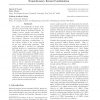Free Online Productivity Tools
i2Speak
i2Symbol
i2OCR
iTex2Img
iWeb2Print
iWeb2Shot
i2Type
iPdf2Split
iPdf2Merge
i2Bopomofo
i2Arabic
i2Style
i2Image
i2PDF
iLatex2Rtf
Sci2ools
ICML
2006
IEEE
2006
IEEE
Nonstationary kernel combination
The power and popularity of kernel methods stem in part from their ability to handle diverse forms of structured inputs, including vectors, graphs and strings. Recently, several methods have been proposed for combining kernels from heterogeneous data sources. However, all of these methods produce stationary combinations; i.e., the relative weights of the various kernels do not vary among input examples. This article proposes a method for combining multiple kernels in a nonstationary fashion. The approach uses a large-margin latentvariable generative model within the maximum entropy discrimination (MED) framework. Latent parameter estimation is rendered tractable by variational bounds and an iterative optimization procedure. The classifier we use is a log-ratio of Gaussian mixtures, in which each component is implicitly mapped via a Mercer kernel function. We show that the support vector machine is a special case of this model. In this approach, discriminative parameter estimation is f...
Discriminative Parameter Estimation | ICML 2006 | Latent Parameter Estimation | Machine Learning | Mercer Kernel Function |
| Added | 17 Nov 2009 |
| Updated | 17 Nov 2009 |
| Type | Conference |
| Year | 2006 |
| Where | ICML |
| Authors | Darrin P. Lewis, Tony Jebara, William Stafford Noble |
Comments (0)

